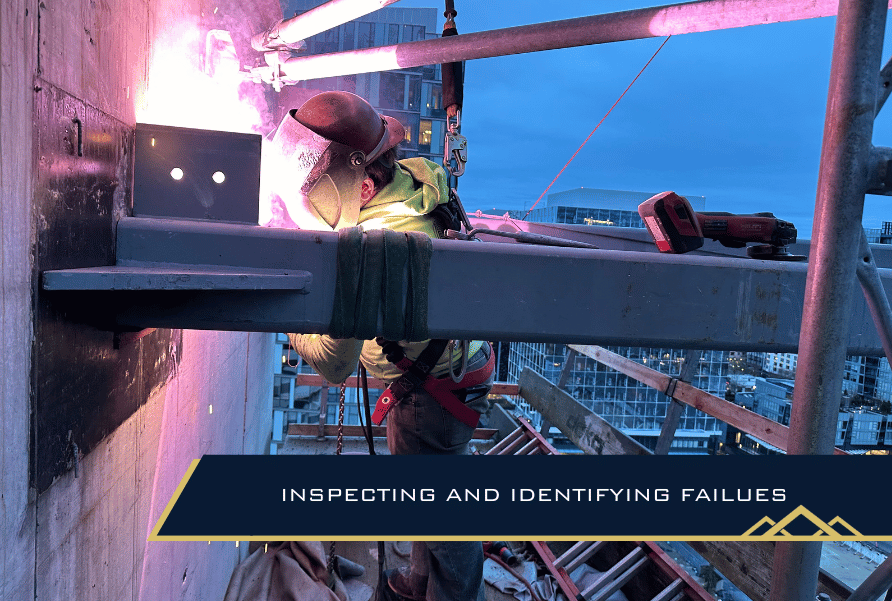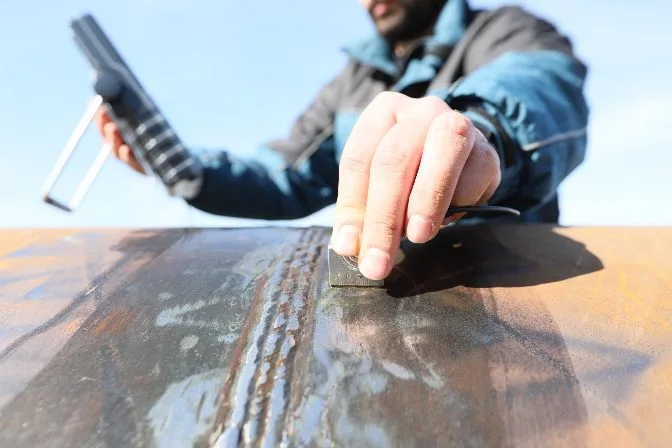Comprehending the Basics of Welding Evaluation to Make Sure High Quality and Safety
In the world of modern-day design, welding assessment stands as a cornerstone for ensuring both the top quality and security of structural developments. The procedure includes a meticulous evaluation of welded joints, using advanced strategies such as radiographic and ultrasonic screening to find surprise blemishes. The expertise of certified inspectors is essential, as they bridge the space between academic standards and sensible application. Their role extends beyond simple discovery, incorporating the documents and interaction of searchings for to appropriate stakeholders. What are the nuances of these evaluation approaches that make them essential for keeping structural stability?

Relevance of Welding Examination
In the world of commercial fabrication, the significance of welding inspection can not be overemphasized. Welding assessment plays a crucial duty in ensuring the honesty, security, and durability of welded structures. Provided the diverse applications of welding in industries such as building and construction, vehicle, aerospace, and shipbuilding, the requirement for strict quality assurance actions is vital. Appropriate assessment ensures that welds fulfill defined criteria and codes, which is necessary for stopping structural failures that could bring about devastating repercussions.
The process of welding naturally involves complex variables, including temperature, material residential or commercial properties, and ecological conditions, all of which can influence the quality of the weld. A detailed inspection identifies problems such as splits, porosity, and incomplete fusion, which can endanger the toughness and reliability of the weld. By identifying these concerns early, rehabilitative activities can be taken, thus minimizing the danger of failure and connected expenses.
Furthermore, welding assessment adds to governing compliance, as several industries are regulated by stringent security requirements and guidelines. Failure to stick to these regulations can result in financial charges and legal liabilities. Eventually, welding evaluation not just safeguards physical frameworks but likewise maintains and secures human lives industry credibilities.

Secret Welding Inspection Methods
Although welding evaluation is crucial to making certain the quality and safety and security of bonded structures, it is the particular methods used that establish the efficiency of the inspection process. Key welding inspection methods can be extensively categorized right into non-destructive screening (NDT) and devastating testing. Non-destructive screening methods such as visual evaluation, ultrasonic screening, radiographic testing, magnetic particle screening, and liquid penetrant testing are mostly used to examine the properties of a weld without triggering damage. Visual inspection is frequently the primary step, entailing a comprehensive examination of the weld's surface for defects like cracks or porosity.
Radiographic and ultrasonic testing are advanced strategies that enable inspectors to analyze the internal integrity of the weld. Ultrasonic testing makes use of high-frequency acoustic waves to discover stoppages, while radiographic testing uses X-rays or gamma rays to create a photo of the weld's interior. Magnetic fragment testing and fluid penetrant testing are surface area assessment techniques made use of to find surface area and near-surface flaws. In comparison, devastating screening techniques include physically breaking or cutting the weld to assess its mechanical properties. These detailed examination approaches guarantee that welds satisfy industry standards and security needs, thus making sure architectural honesty and efficiency.
Function of Licensed Examiners
Qualified assessors play a crucial duty in the welding evaluation procedure, ensuring that all welds abide by rigid industry criteria and safety policies. Their proficiency is vital in determining flaws or irregularities that might endanger the structural integrity of a weld. By thoroughly checking out each weld, certified assessors aid protect against prospective failures that can result in costly repair work or dangerous crashes.
To come to be qualified, assessors have to a knockout post undertake rigorous training and screening, which Recommended Reading familiarizes them with various welding techniques, materials, and testing methods. This thorough knowledge permits them to evaluate weld top quality successfully and make educated judgments about their safety and reliability. Qualified examiners are efficient in analyzing requirements and blueprints, guaranteeing that the welding job lines up with the job's layout requirements.
An important component of their duty is to document their findings extensively, supplying an in-depth record of the assessment procedure. This documentation is critical for traceability and accountability, functioning as a main document of conformity with sector criteria. Qualified inspectors likewise play a key function in promoting interaction in between project stakeholders, supplying suggestions and understandings to boost welding practices and end results. Their payment is important in maintaining high levels of top quality and security in welding operations.

Tools Used in Welding Inspection
Welding inspectors count on a range of specialized tools to do their obligations properly, making certain each weld meets the necessary requirements. Among these tools, aesthetic inspection aids like magnifying glasses and mirrors are essential, allowing examiners to closely take a look at welds for surface flaws such as splits, porosity, and undercut. Calipers and fillet weld evaluates are essential for gauging weld dimensions to verify conformity with style specs.
Advanced devices extend beyond visual help, including non-destructive screening (NDT) tools. Ultrasonic testing tools are essential in detecting subsurface problems, using sound waves to disclose internal gaps without endangering the weld's honesty. Similarly, radiographic testing employs X-rays or gamma rays to catch photos of a weld's inside, highlighting prospective defects.
Magnetic fragment testing is another important device, specifically for discovering surface area and near-surface gaps in ferromagnetic products. By applying magnetic fields and ferrous fragments, inspectors can identify imperfections that could otherwise be unnoticeable.
Dye penetrant examination is usually made use of for non-ferrous products, providing a contrast-enhanced aesthetic check for surface-breaking issues. Welding Inspection link Madison. Together, these devices make it possible for welding inspectors to adequately analyze weld quality, making certain security and dependability in numerous applications across markets
Making Sure Structural Integrity

Welding treatments must stick to recognized requirements and codes, such as those specified by the American Welding Culture (AWS) or the International Company for Standardization (ISO) These guidelines ensure that the welds can withstand ecological factors and functional tensions. Qualified and certified welders play a critical role in this process, as their know-how ensures that methods are applied properly, minimizing problems such as cracks, porosity, and incomplete blend.
Post-weld assessment is another vital component of confirming structural integrity. Non-destructive testing (NDT) techniques, including ultrasonic testing and radiographic testing, are employed to spot subsurface problems without jeopardizing the bonded framework. These evaluations validate that the welds meet the needed quality requirements, offering guarantee of their resilience and dependability. Ultimately, making sure structural integrity in welding not just safeguards human lives but additionally shields financial investments and improves the long life of crafted frameworks.
Final Thought
The principles of welding examination are necessary for keeping the top quality and safety of bonded structures. The usage of specialized tools even more enhances the assessment procedure, inevitably securing human lives and prolonging the life-span of bonded constructions.
Welding inspection plays a critical function in ensuring the stability, safety and security, and longevity of welded structures.Although welding evaluation is vital to making sure the high quality and security of bonded frameworks, it is the details methods utilized that figure out the efficiency of the assessment procedure. Trick welding inspection techniques can be broadly classified right into non-destructive testing (NDT) and harmful screening.Qualified examiners play a critical function in the welding inspection procedure, making sure that all welds comply with strict industry criteria and safety and security regulations.The basics of welding examination are important for maintaining the quality and safety and security of welded frameworks.